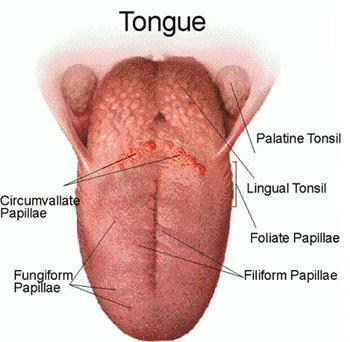Used for tasting, chewing and swallowing food, a person’s tongue is an organ made up of muscles, attached to the mouth’s floor. Papillae are small bumps that cover the top of the tongue. Most of a person’s taste buds sit on those papillae.
A healthy tongue is one that is pink and moist with thin white coating on the surface. Doctors use tongue depressor or stick, to look in the mouth and tongue during an examination because the tongue can be a very good measure of physical well-being.
Common Tongue Problems and their Treatment
Tongue disorders or problems that appear discolored are generally considered harmless and can be treated with home remedies. Other tongue problems may have more serious implications.
White Tongue
 A white tongue is often caused by a removable coating of food debris or bacterial plaque. White tongue is usually caused by a fungal infection and can be classified as oral thrush, leukoplakia, oral lichen planus, hairy leukoplakia or linea alba.
A white tongue is often caused by a removable coating of food debris or bacterial plaque. White tongue is usually caused by a fungal infection and can be classified as oral thrush, leukoplakia, oral lichen planus, hairy leukoplakia or linea alba.
-
Hairy leukoplakia. A hairy and rough white patch on the side of the tongue is caused by the Epstein-Barr virus and an immunocompromising condition. HIV testing is recommended for hairy leukoplakia without a known immunocompromising condition. Treatment options include antiviral medications.
-
Linea alba. This is a benign condition characterized by a thin white line at the lateral borders of the tongue. Known cause is the epithelium thickening due to trauma or irritation from chewing. This problem requires no treatment.
-
Oral lichen planus. An autoimmune response can cause a chronic inflammatory condition of the tongue: reticular lichen planus. Although rare, this condition may lead to oral cancer. A biopsy may be recommended.
-
Leukoplakia. These are white patches on the tongue that cannot be scraped off. Leukoplakia is often linked to longer-term irritation in the mouth. Smoking is the most common contributory factor to leukoplakia. Quitting smoking may resolve the problem. This can be a precursor to oral cancer, which is usually benign.
-
Oral thrush. It is also known as candidiasis, which is caused by yeast overgrowth in the mouth. This can be addressed by scraping off the white patches to expose the red surface on the tongue. Common treatment options for oral thrush are lozenges, tablet or liquid antifungals.
Black tongue
It is usually a harmless condition to have a black tongue and can be caused by smoking, soft diet, medications, dry mouth or poor oral hygiene. What can be alarming is a black tongue associated with elongated tongue papillae. This is usually caused by a change in the normal bacteria in the mouth after using antibiotic treatment, or use of other products such as Pepto-Bismol. Improving diet, smoking cessation and improved oral hygiene are the common treatment options.
Red tongue
Color changes in the tongue may be caused by foods that you eat – red-colored foods such as strawberries, some acidic foods, etc. If the redness disappears after some time, there is no cause for concern. A persistent red tongue however, can be sign of an underlying medical condition like Kawasaki disease, scarlet fever, or vitamin deficiency.
Erythroplakia. This is a red lesion or patch that cannot be rubbed off on the tongue. A lesion has potential risk to be premalignant. A lesion or sore that does not go away should be a reason to be concerned about. Doctors will likely recommend a biopsy with an oral surgeon or ENT specialist to rule out oral cancer.
- St. Lawrence Dentistry Looks Forward To St. Patrick’s Day! - March 12, 2025
- Understanding Dental X-Rays and Radiation: What You Should Know - January 13, 2025
- Happy New Year from St. Lawrence Dentistry! - December 30, 2024









